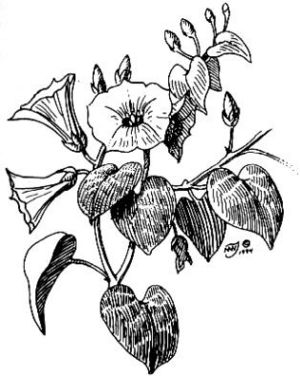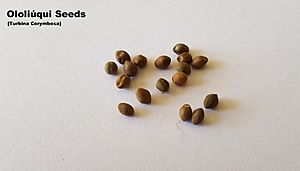Ipomoea corymbosa facts for kids
Quick facts for kids Ipomoea corymbosa |
|
|---|---|
 |
|
| Scientific classification | |
| Genus: |
Ipomoea
|
| Species: |
corymbosa
|
| Synonyms | |
|
List
|
|
Ipomoea corymbosa is a type of morning glory plant. It grows naturally across Latin America, from Mexico all the way south to Peru. It has also spread and now grows in many other places around the world. People often call it Christmasvine, Christmaspops, or snakeplant.
Contents
About the Plant
This plant is known by different names in various cultures. In parts of Mexico, people call it Ololiúqui in the Nahuatl language. In southeastern Mexico, especially among the Mayan people, it's called xtabentún.
What it Looks Like
Ipomoea corymbosa is a perennial vine that climbs. This means it lives for many years and grows upwards, often wrapping around other plants or structures. It has pretty white flowers.
Sweet Nectar and Honey
The flowers of this plant make a lot of sweet liquid called nectar. Bees love this nectar! They use it to make a very clear and fragrant honey. In Cuba, this plant usually blooms from December to February. It is considered one of the most important plants for honey production on the island.
Traditional Uses
For a long time, native people in Mexico have used this plant for special purposes. They would use the powder from its seeds in ceremonies. These ceremonies were often for understanding the future or connecting with spiritual beliefs. When Europeans first arrived, they sometimes misunderstood these traditions. Because of its widespread use, some colonial authorities tried to ban it.
Seeds and Their Chemistry
The word ololiuhqui in Nahuatl actually means "round thing." This name refers to the small, brown, oval-shaped seeds of the plant. The plant itself has other names, like coaxihuitl ("snake-plant") in Nahuatl. In Spanish, it's sometimes called hiedra, bejuco, or quiebraplatos. The seeds are also sometimes called semilla de la Virgen, meaning "seeds of the Virgin Mary".
Scientific Discoveries
For a long time, not much was known about this plant outside of Mexico. In 1941, a scientist named Richard Evans Schultes identified the plant as Turbina corymbosa. Later, in 1960, another scientist named Albert Hofmann studied its chemical makeup. He found that the seeds contain natural compounds called ergine (LSA). These are a type of alkaloid, which are natural chemicals found in plants.
Where it Grows
This plant is native to many parts of Latin America. However, it has also become an invasive species in some areas. This means it has spread to places where it doesn't naturally belong. It can sometimes grow so much that it takes over and harms local plants. You can find it growing wild in the United States, parts of Europe (like Spain), and Australia.
See also
 In Spanish: Xtabentún para niños
In Spanish: Xtabentún para niños
- Xtabay


